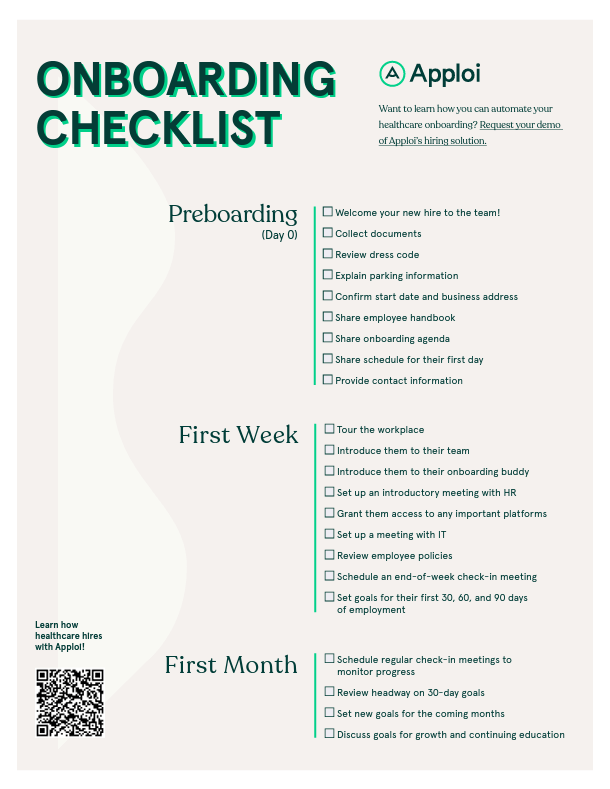Skilled Nursing Retention: 10 Tips for Reducing Turnover
Keeping your skilled nursing facilities staffed and ready is no small task. Employers must balance recruiting, talent planning, and retention. And in skilled nursing, improving retention is a complex task.

Skilled nursing retention is a massive problem, with average turnover rates estimated as high as 94%.
But what can employers do to increase retention—and why should they bother? We’ve put together ten tips to help fight turnover.
In This Series
- Staffing Guide for Skilled Nursing Facilities
- Seven Ways to Improve Your Skilled Nursing Orientation
- Nursing Home Hiring: Tips for Recruiting 7 Common Roles
- Healthcare Terminology for Skilled Nursing HR
- Skilled Nursing Retention: 10 Tips for Reducing Turnover
- Skilled Nursing Compliance Q&A with Healthcare Law Attorneys

FREE INTERACTIVE ONBOARDING CHECKLIST
Specifically designed for Skilled Nursing Facility Roles
Why Focus on Skilled Nursing Retention?
Employers with robust recruiting strategies in place might wonder if high turnover is inevitable. If everyone experiences turnover, is it even worth fighting?
While it’s true that high turnover is an almost industry-wide phenomenon, it does have significant effects on individual facilities.
It doesn’t have to be this way. Here’s why skilled nursing retention is so important.
Turnover Amplifies the Candidate Shortage
The most obvious reason to focus on skilled nursing retention is that we’re in the middle of a worker shortage. In many cases, holding onto your current staff is easier than finding new employees (not to mention, more budget-friendly).
Among nursing home providers, 87% say they’re dealing with moderate to severe staffing shortages. Another 71% reported that the candidate shortage was their greatest staffing challenge.
Retention Is Cheaper Than Recruiting
Replacing employees is pricey. According to LeadingAge, the cost of replacing any worker is about 25% of their annual salary.
There’s no reason to spend that money on new candidates if you don’t have to. Focus on retention first to avoid exorbitant replacement costs.
Staff Retention Improves Patient Outcomes
On top of that, better retention leads directly to better care. When healthcare businesses have less turnover, they can provide better continuity of care. Plus, long-term workers are generally more confident navigating their facility than newer employees.
Healthcare workers and residents also build important relationships. These relationships are particularly important in long-term care settings, where staff are a significant piece of residents’ community. When turnover increases, patient satisfaction and care levels both drop.
How to Improve Retention in Skilled Nursing Facilities
Amid the challenges, there’s also good news. There are real strategies employers can put in place to understand, reduce, and plan for turnover.
Here are ten actions employers can take to encourage workers to stay.
1. Build Flexibility Into Scheduling
For employers under pressure, flexible scheduling might sound like a pipe dream. It’s true that implementing flexible schedules is a challenge, but the effort pays off with long-term staffing benefits. A full 80% of job seekers would opt for a job with shift flexibility over a job with strict shifts.
Hold onto workers who need flexible schedules to attend to other responsibilities (such as parenthood) with these tactics.
Shift Bidding
Shift bidding works like a reverse auction. Employers post open shifts to an online portal, along with a (relatively high) starting pay rate. Employees can then bid on the shift by offering to work for a lower rate, and the employer awards the shift to one of the bidders.
The key to making shift bidding successful is to offer a rate that’s high enough to get workers excited. Ideally, workers will earn more than their usual rate, while employers will pay less than they would for a temporary worker.
Shift Swaps
Shift swapping is a simpler, and, for many, more familiar solution. Just let workers swap shifts at their discretion (with manager approval).
Employers might use scheduling software to streamline this process, making it easier for workers to advertise a job they wish to swap. They may also facilitate shift swapping through professional software, such as Slack.
Part-Time and Unconventional Schedules
While long shifts are often normalized in healthcare, not every worker can accommodate them. Some employers are dealing with this by allowing workers to pick up unconventional shifts.
Ultimately, it’s better to retain a worker who works part-time or relatively short shifts than to watch a worker take on 16-hour shifts until they burn out. Plus, both employee and patient satisfaction increase when clinical workers have shorter shifts.

If you’re introducing flexibility into your shift scheduling, you might find that there are huge discrepancies in the hours different employees work. That’s not inherently a bad thing, but it can be dangerous to let one worker take on excessive amounts of overtime.
Employers can help prevent burnout by placing limits on overtime and shift length. Keep an eye out for workers repeatedly picking up lengthy shifts. Even if they are willing to take on this work, a grueling schedule could still cause exhaustion and shorten their tenure at your facility.
3. Mandate Time Off
Enforced time off is a debated strategy among HR professionals. But the evidence shows that without enforcement, workers don’t take adequate vacation time.
For healthcare, that’s especially important. Workers in skilled nursing facilities already feel the pressure of a high-stakes, often understaffed industry. Time to rest and recharge is critical to a healthy and sustainable working life. Employers can support work-life balance by mandating a minimum number of days off and reminding employees to take their personal time.
FREE Skilled Nursing Retention Infographic
Review the top 10 ways to retain your workers at a glance.
4. Create Career Opportunities
Some of the healthcare roles in highest demand also require the fewest hours of training.
The good thing about this is that employers may be able to train much-needed candidates in-house. But the downside is that, without a clear path forward, workers like nursing assistants and home health aides may struggle to envision future career growth.
Employers can help workers see a future for themselves by tracking career goals, financially supporting ongoing education, and routinely promoting and hiring from within.
5. Engage Employees in Open Dialogue
Recently, Becker’s Hospital Review asked 22 healthcare executives what factors contributed to retention and turnover in their businesses.
Across these responses, one thing came up over and over again: employee engagement.
Employee engagement has been a major concern in healthcare for some time. In fact, 89% of respondents to an HR Healthcare survey reported that patient care improved when employees were engaged.
Luckily, there are things you can do to improve employee engagement today. These include check-in meetings, stay interviews, and opportunities for anonymous feedback. Giving and soliciting feedback is the easiest way to understand if employees are satisfied with their work.
I think we, as leaders, need to build an open, just culture in our hospitals in which all our colleagues feel safe and confident in speaking up about patient and staff safety issues and events at all times. This will go a long way to restoring joy and meaning to our work in the healing arts.
–Vincent Barba, MD. CMO at Matheny Medical and Educational Center (Peapack, N.J.)
6. Recognize Employee Work
There’s more than one way to engage employees. Among these, one of the most important approaches is recognizing workers’ accomplishments, big and small.
Employee recognition is so important, Gallup listed it as one of the 12 core indicators of workplace engagement. When staff members are seen and celebrated for their contributions, they’re more likely to feel engaged and satisfied.
On the other hand, feeling underappreciated by work and society at large is one of the most common reasons skilled nursing employees quit.
To fight this, and improve skilled nursing retention in your facility, recognize employees frequently, specifically, one-on-one, and in public. Consider incentive programs to reward employees who stick around for a year or more, or peer-to-peer recognition programs where coworkers can celebrate each other.
Ideas for Employee Recognition
- Ask supervisors or coworkers to write notes of appreciation for other employees. Read these notes in an all-team meeting to maximize the impact.
- Do a coffee run for everyone currently working (or one team at a time).
- Hire a masseuse to give 15-minute massages in the break room to help employees relax.
- Shout-out an underappreciated worker on social media. This is great for morale and for your brand.
- Set out a box, note paper, and markers, and encourage workers to submit anonymous notes of appreciation for their colleagues. Post these notes in the break room for everyone to enjoy.

7. Designate Mentors
Mentorships can happen organically, but employers can also designate mentors and mentees to guarantee these relationships take form.
These relationships can be meaningful for both mentors and mentees. Not only can mentorships help new workers feel more comfortable and confident—they can also improve mentors’ job satisfaction.
By asking a worker to serve as a mentor, you’re recognizing their expertise and positioning them as natural leaders, no matter their role or title. For team members who are interested in pursuing leadership, mentorship can also be an important career step.
Be sure to only include mentors who are genuinely enthusiastic about the program, however. Mentorship is work, and ambivalent participants might end up feeling that they’ve been saddled with an extra burden.
8. Increase Workloads Slowly
For new graduate nurses, the intention to turnover is directly correlated to job stress and sleep disturbances. New nurses are particularly susceptible to anxiety, which can lead to premature burnout and early departures from their jobs.
To combat this, employers can plan for new hires’ workloads to increase slowly over time. New workers who aren’t overloaded are more likely to build an early commitment to their workplace, and to feel prepared for challenges by the time they occur.
9. Allocate Staff Correctly
The right scheduling strategy will help workers feel confident and prepared, all while improving patient care. There are three main ways to allocate clinical staff: based on budget, patient ratios, and patient acuity.
But no matter what approach you choose, you also need to consider your staff’s skill mix. Determining the right skill mix is complicated, and specific to your organization and patients. You can start by assessing your patients’ needs, the duties staff members are able to perform, patient outcomes, and functions you may be missing.
Sometimes errors occur simply because of short staffing. But often, efficiency, patient outcomes, and job satisfaction can all be improved with more strategic staff allocation.

10. Update Your Systems
Updating administrative software may be a slow-moving process, but it can also increase productivity, performance, and employee morale. Eleanor Feldman Barbera, author and psychologist specializing in long-term care, lists “inability to deliver high-quality service due to workplace/system issues” as one of the most common reasons workers quit. In other words, workers are frustrated when administrative failures prevent them from doing their jobs well.
In general, healthcare workers express positivity toward new technology. While more experienced nursing staff tend to be more resistant, this is related to poorly-performing technology. In other words, workers dislike using technology that is slow, poorly designed, and dysfunctional. That’s all the more reason to keep software updated.
Healthcare Recruitment Software Made for Your Industry
Interested in learning more about how you can recruit, hire, and onboard healthcare staff quickly? Contact us today for a free demo of our human capital management solution.
In This Series
- Staffing Guide for Skilled Nursing Facilities
- Seven Ways to Improve Your Skilled Nursing Orientation
- Nursing Home Hiring: Tips for Recruiting 7 Common Roles
- Healthcare Terminology for Skilled Nursing HR
- Skilled Nursing Retention: 10 Tips for Reducing Turnover
- Skilled Nursing Compliance Q&A with Healthcare Law Attorneys



2. Place Limits on Shifts